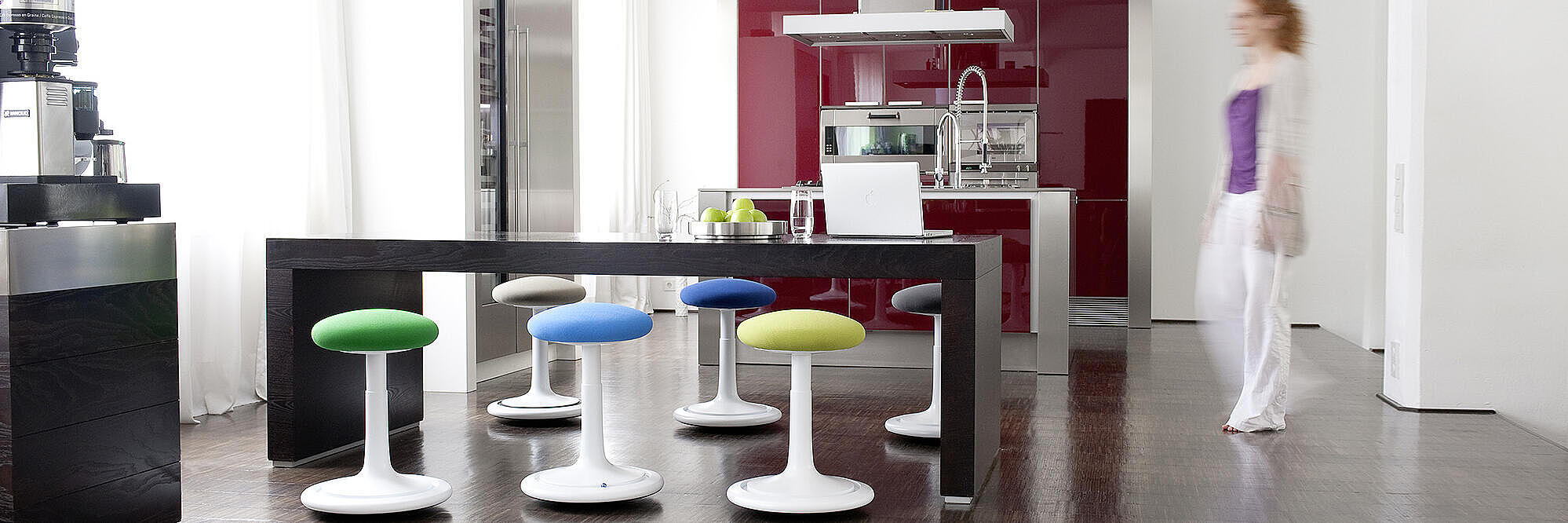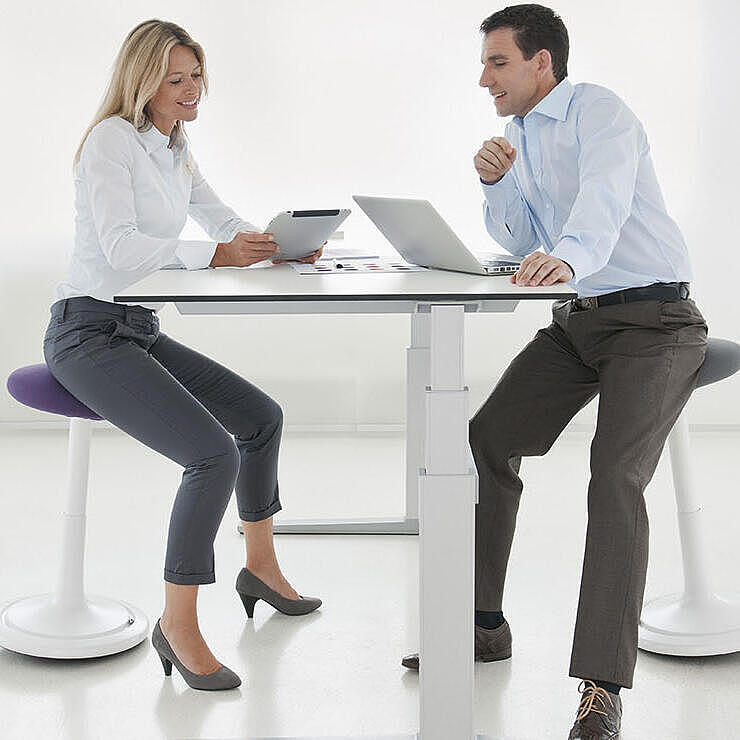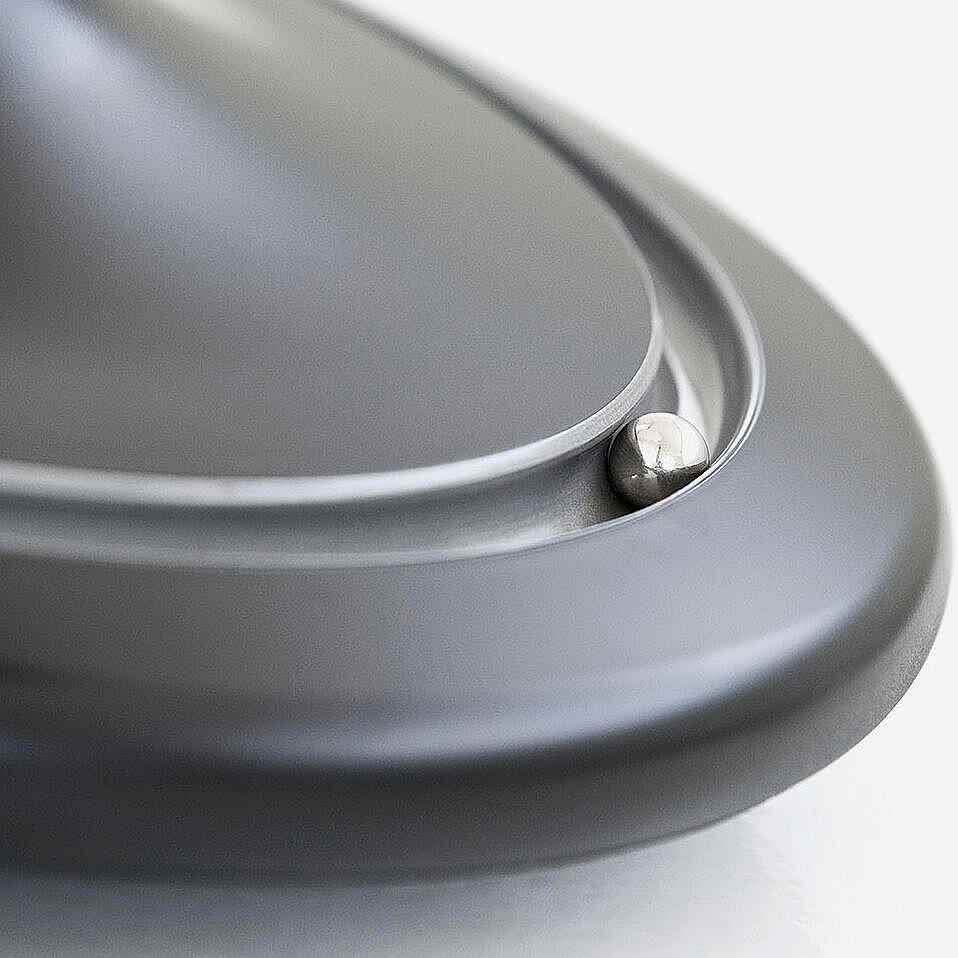

ONGOClassic - the ergonomic stool
Sit yet move. The ONGO Classic beautifully combines these somewhat contradictory ideas oder conditions thanks to a curved bottom that reacts to any shift in weight, activating muscles and blood circulation. A rotating ball in the foot of the stool gives discreet, acoustic feedback whenever the angle changes. The seat cover, body and base of the ONGO®Classic are available in many colors and materials, so it stands out everywhere: at a desk or in teamwork, in the office or at home. Both the ONGO Classic, ‘regular’ version and the ONGO Classic ‘tall’ version, which can be extended to a standing stool, can be carried easily to wherever you need it, thanks to its light body.
Features
- Sophisticated design and high-quality craftsmanship.
- Versatility, with different colors available for the seat cover, body and ball track.
- High-quality pneumatic seat height adjustment with anscrewing protection.
- Easy to move: lightweight, with a groove around seat for carrying.
ONGOClassic in regular or tall
The ONGO Classic is available in two different seat heights:
ONGO Classic regular, adjustable height between 46 and 66 cm
ONGO Classic tall, adjustable height between 55 and 78 cm.
The regular ONGO Classic is suitable for standard table heights. The height can be adjusted to your ideal seat height. To ensure optimum blood circulation, your legs should form a slightly open angle (slightly greater than 90 degrees) in relation to your upper body.
The tall ONGO Classic is designed for the growing number of desks with adjustable heights because it “grows” easily with them. When used as a tall stool, your legs should create a 135 degree angle in relation to the upper body for optimal circulation. The beauty is that you can use it at a tall desk or conference table or at the bar in the kitchen as a tall stool or as a shorter one in its low position.

Product data

There are two versions of the ONGO Classic
- regular: seat height 46–66 cm
- tall: seat height 55-78 cm
- seat surface (diameter) 39 cm
- foot (diameter) 42 cm
- weight approx. 5.7 kg
- made in Germany
- design, material and assembly guarantee consistent quality and long life
- two years warranty on all original parts
Seat covers
ONGO Classic is available in seven different seat covers in up to 12 colors each.
- Fabric: 95% polyester and 5% spandex, thread according to Oeko Tex 100 color fastness in accordance with automotive standard. Available in 12 colors.
- skai leatherette: High-quality skai® material, long lasting, lightfast, abrasion-resistant. Available in six colors.
- skai Dynactiv™ Makari 160: approx. 89% PVC compound and approx. 11% cotton, lightfastness 6, Abrasion cycles 150.000 Martindale, antibacterial, salt water resistant
- kvadrat Remix 2: 90% new wool, 10% nylon, gaberdine, lightfast, abrasion-resistant. Available in six colors.
- kvadrat Divina Melange 2: 100% new wool, lightfast, abrasion-resistant. Available in six colors.
- Leather: fine leather, nonfading, abrasion resistant, tearproof. Available in six colors.

Further information
For some time now, the topic of "healthy sitting" has been established in both the social and professional environment. The correct sitting posture is an extremely important factor in preventing or effectively combating tension or back pain, for example. Many people opt for a sturdy office stool, which at least improves their sitting posture and is also an explicitly inexpensive solution. However, if you really want to achieve the best possible sitting position or posture, you should always opt for an ergonomic office chair. An ergonomic stool - like the Ongo Classic - encourages active sitting in the long term. In addition, an ergonomic stool generally promotes a better posture for the back, which has a gentle effect. You should always remember that your general well-being and ability to concentrate at work also depend on whether you feel physically well or have problems (in this case, with your back).
The utilization of ergonomic office stools bestows the following advantages upon the user:
- An ergonomic stool permits the user maximum freedom of movement and facilitates or encourages a variety of movements during activities conducted in a seated position.
- The absence of a backrest in their design encourages better posture from the outset.
- Ergonomic stools, exemplified by the Ongo Classic, are typically lightweight, robust, space-saving, and comparatively durable due to their uncluttered design. Office chairs of this type provide users with significantly greater flexibility in terms of posture and sitting position.
- If an ergonomic office chair has casters, this enhances both freedom of movement and the range of movement. Conversely, if it has a fixed base, a stool of this type offers optimal stability.
Overall, an ergonomic stool offers greater freedom of movement to an office computer worker, graphic designer or architect, for example, and also allows the all-important movement when sitting. In addition, the stool's design requires good posture from the start. In practice, however, new users sometimes have to get used to this new but better posture. Of course, the wrong posture can also be adopted on ergonomic office chairs. The advantage of this is that an incorrect posture on an ergonomic chair is extremely uncomfortable and therefore quickly noticed by the person concerned, so that they can quickly correct their sitting or body posture.
The specific problem with sitting is that the human pelvis has a fundamental tendency to rotate backwards as soon as you sit down. It is precisely this rotation of the pelvis that has a negative effect on a person's posture and the shape of the spine. This is because the spine normally has a natural curvature that changes into a hunched posture. The natural curvature of the spine then becomes a hunchback posture, which puts excessive strain on the discs in the lumbar spine. Pelvic rotation is particularly pronounced when the angle between the thighs and the torso is right-angled (90°) or less. Many articles still consider this to be the optimal sitting position. According to the latest findings, however, this is a fatal error. This posture is particularly hard on the intervertebral discs.
Instead, a so-called "open seat angle" of more than 90° is a much better alternative. However, no fixed values can be given here, as subjective decisions play a major role. It always depends on the type of office chair and the height of the desk which open seat angle is more ergonomic for the individual. In any case, it is a fact that an ergonomic stool with an open seat angle puts significantly less strain on the lumbar spine. An ergonomic stool, such as the Ongo Classic, gives you the opportunity to straighten your upper body while sitting; at the same time, the relaxed abdominal area provides more space and freedom for much deeper breathing. The Ongo Classic stool is designed to automatically straighten your body when you sit.
There are several ways to achieve the advantageous open seat angle without sliding too far forward on an inclined or slanted seat:
- The chair has a saddle seat, which provides the proper support in an ergonomic open-back office chair.
- If the office chair has a seat height adjustment, which allows you to adjust the seat tilt, you can easily choose an angle that is subjectively comfortable.
- If you work at a raised desk, you can also use a standing aid. In practice, those with a concave foot plate have proven to be the most effective. This gives you two advantages. First, it allows you to adjust your sitting angle, and second, it encourages you to move around while sitting.
- Alternatively, a ball-box or wedge cushion that you simply place on the seat can also help.
An ergonomic chair with an open sitting angle can also have another advantage. With an ergonomic office chair such as the Ongo Classic, a significant portion of the total body weight is placed primarily on the feet, which is not the case with conventionally designed office chairs. This increased load on your feet provides an additional stimulus for your legs to provide the appropriate impulses for your body to move. In addition to movement while sitting, you should always pay attention to the correct work environment around desks and monitors. This is directly related to sitting correctly on an ergonomic stool or office chair. This is especially important at a computer workstation. Ergonomically designed workstations support and encourage good posture when sitting. For example, your elbows should always be at a right angle when typing at the keyboard. You should also adjust the monitor so that it is slightly below your horizontal line of sight - at least an arm's length away. The mouse and keyboard should always be in line with your elbows. Also, do not bend your hands when using the mouse and keyboard. Keep your feet firmly planted on the floor.
Whether it's a traditional office chair or an ergonomic stool, you need to learn how to sit properly on both. Once you know how it works, it is easy to find the right posture when you sit. Seat height is especially important. This is determined by your lower leg. An ergonomic stool is at the correct height when your thigh forms a sloping line with your knee; your knee must always be lower than your hip. When you place your feet on the floor with the soles of your feet or shoes, your thighs and lower legs should be at a visible right angle. Many ergonomists now recommend an angle slightly greater than 90 degrees. By adjusting your seat height in this way, you open up your seat or hip angle. This gives your pelvis more room to move forward, giving your spine the proper foundation for continuous body alignment. On the other hand, if the seat height is set too low, your pelvis will automatically tilt backward. The result is a tense, hunched posture that can quickly take a toll on your lower back. On the other hand, if your seat is too high, you will experience instability and muscle tension in your legs.
An ergonomic stool can only serve its purpose if the desk is at the optimal height for the selected seat height. To protect your back in the long term, desks should be set at a height that allows your forearms to rest loosely on the desk top at a right angle to your forearms. Desks with a wide range of heights are an interesting option here. For example, you can find models that can be converted from a desk to a standing desk. This greatly increases your flexibility and allows you to alternate between standing and sitting while working on your ergonomic stool.
In addition to these explicitly height-adjustable desks, you need a functional stool that offers a wide range of height adjustments. An ergonomic stool like the Ongo Classic meets this requirement. As a flexible ergonomic stool, this model offers you an enormous height range. So this stool simply grows or shrinks - depending on your current needs - and always adapts to the height of your desk. You can even benefit from the health benefits. For example, when the ergonomic Ongo Classic stool is used as a standing seat, you can be sure of optimal blood circulation when your legs are at a 135° angle to your upper body.